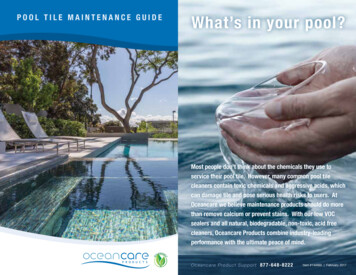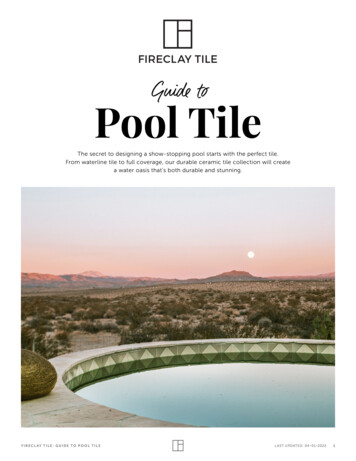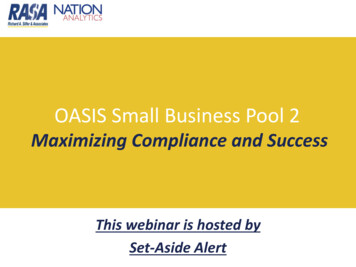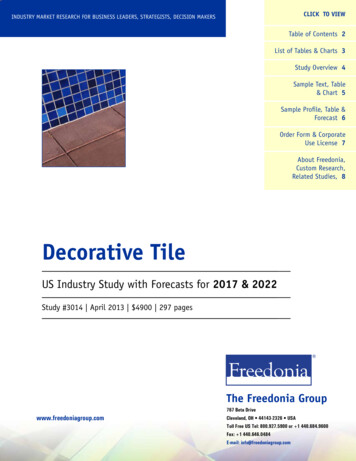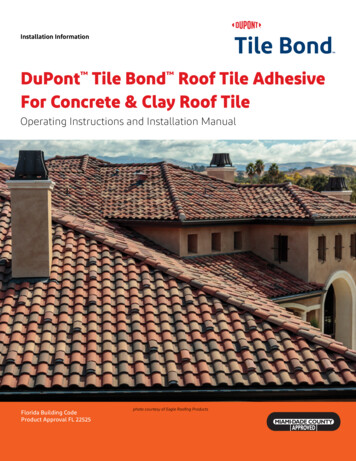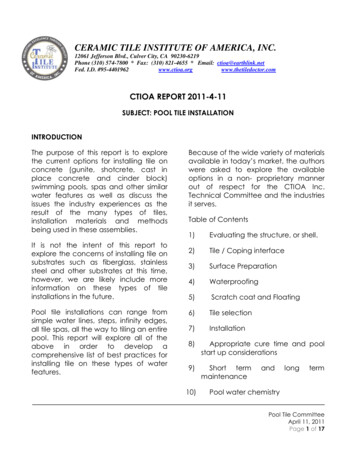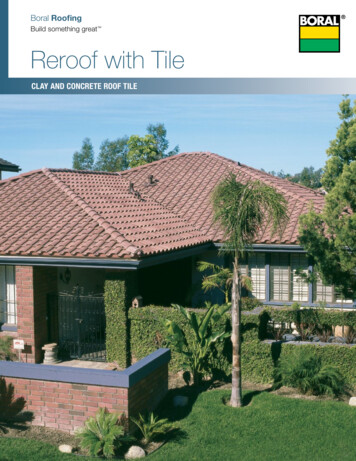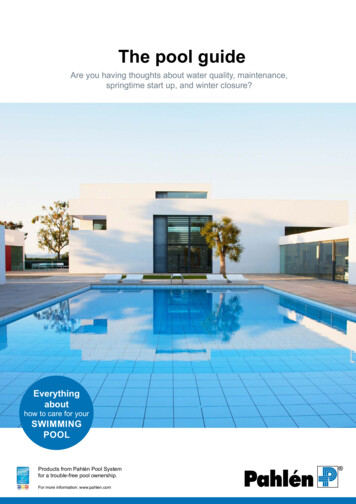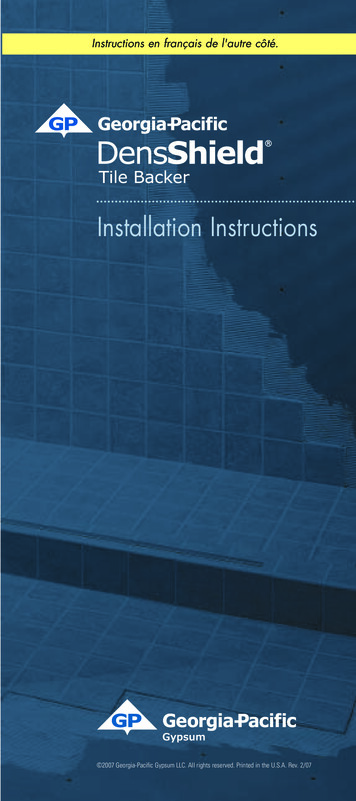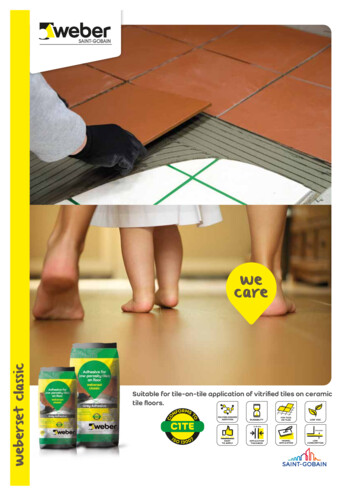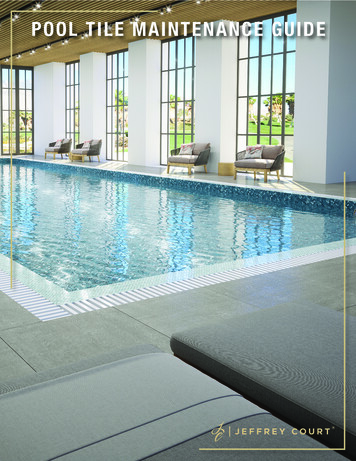
Transcription
POOL TILE MAINTENANCE GUIDE
Proper care and maintenance is crucial to the long-term appearance andperformance of pools and water features. The following information outlinesrecommended products and techniques for the cleaning, sealing and protectionof most pool and exterior tile and is general in nature.WATER BALANCEStart-Up: Source water should be tested prior to filling and adjusted per industr yguidelines such as the National Plasterers Council’s “Swimming Pool Start-UpProcedures”’ available at www.npconline.org. Fill water low calcium hardness,low pH and/or low alkalinity can be corrosive to plaster, grout, thin-set mortar,concrete, natural stone and metals.Ongoing Maintenance: Proper water balance and chemistry is critical for controllingcalcium deposits (mineral scale). Water balance is calculated via the Langelier SaturationIndex (LSI). The water’s LSI is a numeric expression of the water’s balance and takesinto consideration multiple factors. When water is balanced the LSI equals zero andvariation between 0.0 and 0.5 is considered acceptable. LSI levels greater than 0.5may lead to water cloudiness and accelerated mineral scaling. Negative LSI levels maylead to corrosion of cement-based materials (e.g. plaster & Grout) and metal surfaces.Pool water chemistry should be measured and maintained by a pool-maintenacneprofessional.SEALING POROUS MATERIALSSealers are beneficial for natural stone, masonr y (i.e. coping) andcement-based grouts. To protect porous materials and ease maintenance, wesuggest sealing installations with either Oceancare High Performance PenetratingSealer (natural look) or Oceancare High Performance Enhancing Sealer (colorenriching).PREVENTING CALCIUM BUILD-UPTo inhibit the bond of calcium deposits, we suggest applying Oceancare Glass & TileShield to new and/or clean pool tile. Protected tile surfaces will be easier to maintain andmost calcium deposits can be removed with regular brushing or scrubbing, dramaticallyreducing or even eliminating the need for chemical cleaners or aggressive cleaningmethods. for optimum protection, we suggest applying Glass & Tile Shield to pool tileevery 6 months.
GENERAL MAINTENANCEPool tile should be brushed or scrubbed as part of a weekly pool maintenanceprogram. Avoid the use of pumice stones or wire brushes, which can damagetile surfaces.To remove waterline scum and grime, we suggest applying Oceancare All PurposeCleaner & Degreaser to tile surface and scrub with a nylon bristle scrub brush or a 3MWhite or Blue nylon scrub pad.To remove mineral scale and calcium deposits, we suggest applying OceancareCalcium Releaser to tile surface and scrub with a nylon bristle scrub brush or a 3MWhite or Blue nylon scrub pad. Do not use abrasive or acidic cleaners.MEDIA-BLASTINGIn cases of heavy calcium deposits, mineral scale or neglected tile, media-blasting maybe necessary. Media-blasting is a process in which an abrasive material is pressurizedand shot at a surface to remove heavy deposits. This is generally performed by pool tilecleaning specialists through the use of portable media-blasting equipment. An array ofblasting media is available, ranging from glass bead (aggressive) to baking soda (mild).Generally, baking soda or similar hardness blasting media (i.e. kieserite) is aggresiveenough to remove scale but is safe for tile (including glass tile). As with all cleaningprocedures, this process should be tested in an inconspicuous area to ensure the resultswill meet your expectations and not damage the tile surface.Once media-blasting is complete, pool tile installations should be sealed, protected andregularly maintained.WARNING Certain acids will damage tile glaze and iridescent glass tile. Careshould be taken to protect tile surfaces when using acids in the pool finishingprocess and when adding acid to the pool water. DO NOT allow productsthat contain hydrofluoric, hydrochloric, muriatic or phosphoric acid to comein direct contact with the tile. In the case of accidental contact, neutralizeimmediately with baking soda and water (1 lb: 3 gallons).NOTE: Always wear personal protection equipment, follow instructions forproduct use and protect surrounding surfaces when using cleaning or sealingproducts. Test all products in an inconspicuous area for desired effect.
EXISTING TILENEW TILESEALING, PROTECTION & MAINTENANCE SYSTEMS FORGLASS TILE123412345Seal grout with OceancareHigh Performance Penetrating Sealer(prevents staining)Protect tile & grout with OceancareGlass & Tile Shield(inhibits calcium build-up)Clean tile & grout regularly with OceancareAll Purpose Cleaner & DegreaserEvery 6-12 months clean tile & grout withOceancare Calcium Releaser and reapplyGlass & Tile ShieldRemove calcium deposits with OceancareCalcium Releaser(heavy deposits may need to be media blasted)If needed, restore faded/etched tile withOceancare Pool Tile RestorerProtect tile & grout with OceancareGlass & Tile Shield(inhibits calcium build-up)Clean tile & grout regularly with OceancareAll Purpose Cleaner & DegreaserEvery 6-12 months clean tile & grout withOceancare Calcium Releaser and reapplyGlass & Tile Shield
What’s in your pool?Most people don’t think about the chemicals they use toservice their pool tile. However, many common pool tilecleaners contain toxic chemicals and aggressive acids, whichcan damage tile and pose serious health risks to users. Webelieve maintenance products should do more than removecalcium or prevent stains. Low VOC sealers and all natural,biodegradable, non-toxic, acid free cleaners are essential forproviding peace of mind and superior performance.Jeffrey Court Customer Service (951) 340-3383
Shield to new and/or clean pool tile. Protected tile surfaces will be easier to maintain and most calcium deposits can be removed with regular brushing or scrubbing, dramatically reducing or even eliminating the need for chemical cleaners or aggressive cleaning methods. for optimum protection, we suggest applying Glass & Tile Shield to pool tile
